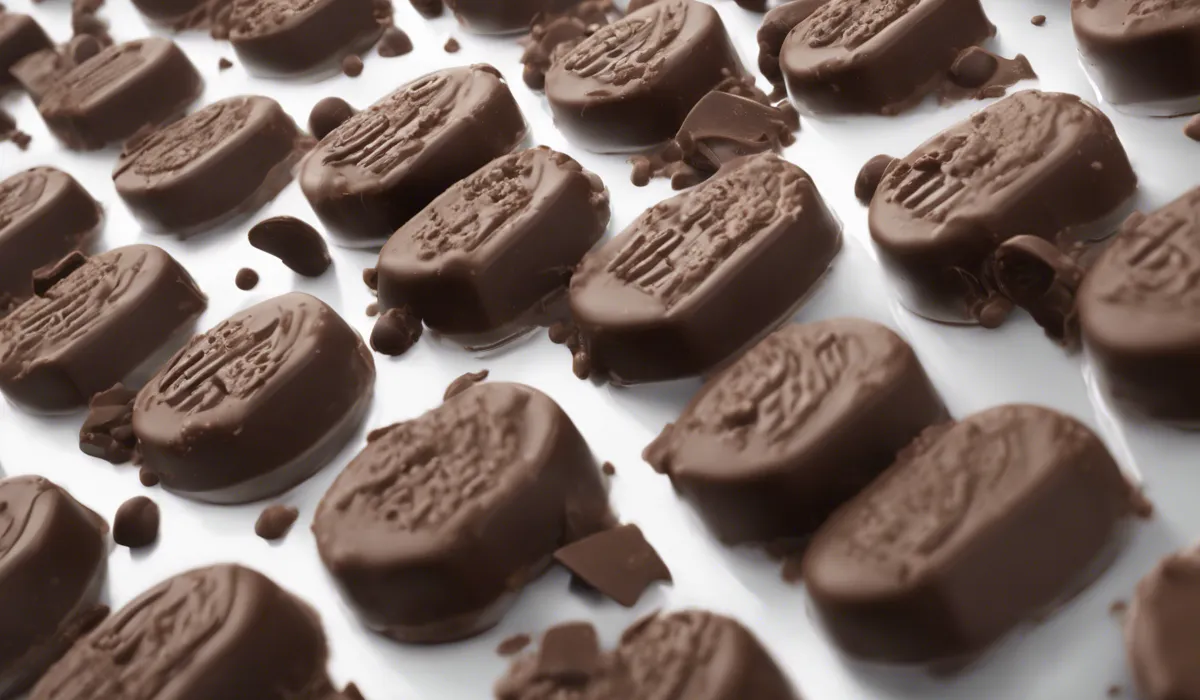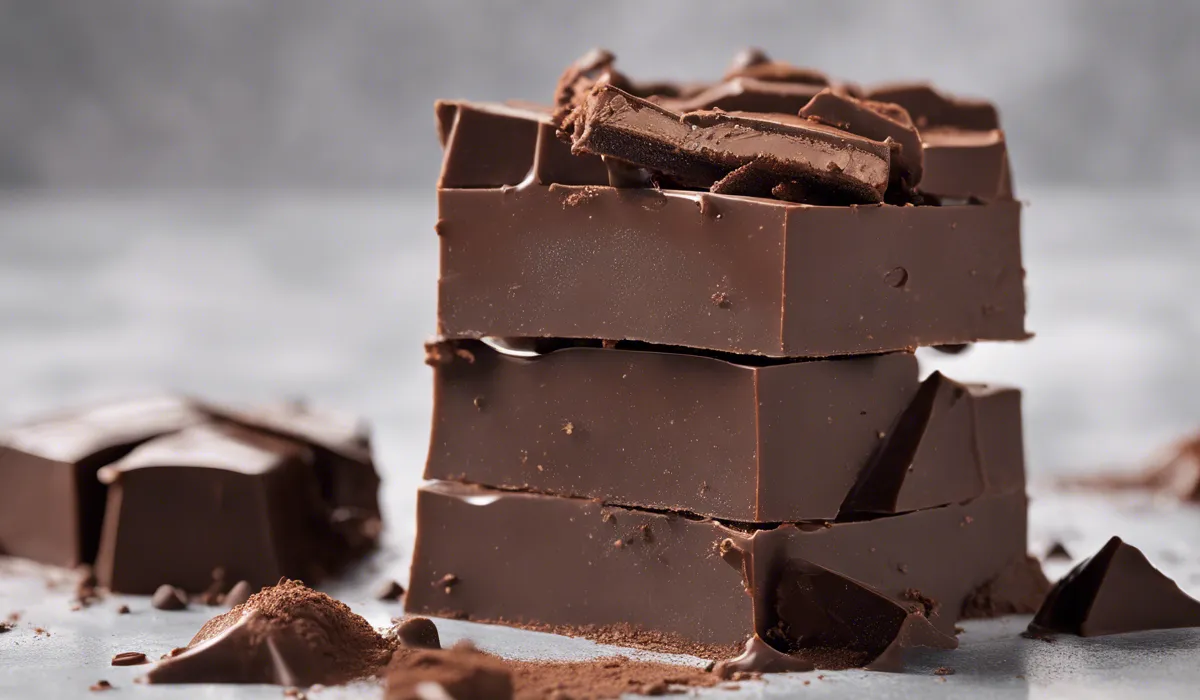Yes, chocolate can grow mold if it’s exposed to moisture or stored improperly. Mold on chocolate appears as white or gray fuzzy spots. To prevent this, keep chocolate in a cool, dry place and well-sealed.
Understanding Chocolate and Mold Growth

What Is Mold?
Mold is a type of fungus that can grow almost anywhere there is moisture, warmth, and something for it to eat.
Think of mold as tiny plants that do not need sunlight to grow. Instead, molds spread by releasing spores into the air. These spores can land on food and start to grow if the conditions are right.
Conditions for Mold to Thrive
Mold loves to grow in places that are moist, warm, and full of nutrients. Chocolate, when exposed to these conditions, can become a home for mold.
Even though chocolate does not have a lot of moisture, it can still get moldy if it’s kept in a damp place or if water gets into the packaging.
Composition of Chocolate
Chocolate is made up of sugar, fat, and sometimes milk. Dark chocolate has more cocoa and less milk, while milk chocolate has more milk and less cocoa.
White chocolate is mostly sugar and milk, with cocoa butter but no cocoa solids. Each type of chocolate has different nutrients that mold might like to eat.
Mold Growth in Different Chocolates
Dark chocolate is less likely to grow mold because it has less sugar and milk. Milk chocolate and white chocolate have more sugar and milk, which can make it easier for mold to grow.
However, sugar also acts like a preservative that can help keep mold from growing.
Sugar as a Preservative
Sugar can help to stop mold from growing because it takes water out of food. When there is less water, mold has a harder time growing.
This is why chocolate, which is high in sugar, can last a long time without getting moldy if it’s kept dry.
Factors That Influence Mold Growth on Chocolate

Humidity and Storage
Where you keep your chocolate can make a big difference. If chocolate is kept in a place that is too damp, like a fridge with a lot of moisture, it can get moldy.
A dry pantry or cupboard is a better place for chocolate to stay fresh.
Temperature Changes
When chocolate goes through big changes in temperature, it can “sweat” and create moisture. This moisture can lead to mold.
Keeping chocolate at a steady, cool temperature helps stop this from happening.
Expiry and Shelf-Life
Chocolate has a date on the package to tell you how long it will be good to eat. If chocolate gets too old, it might not taste good, and there is a higher chance it could get moldy.
Always check the date and eat your chocolate while it’s fresh.
Water Activity in Chocolate
Water activity measures how much water is in food that mold can use to grow. Chocolate has low water activity, which makes it hard for mold to grow.
But if chocolate gets wet or is kept in a very humid place, the water activity can go up, and mold can start to grow.
Cross-Contamination Risks
Mold can also come from other foods or surfaces that are moldy. If you put chocolate next to bread that has mold, or on a cutting board that wasn’t cleaned well, it can get moldy too.
Keeping chocolate away from other foods and cleaning your kitchen well can help stop mold from spreading.
Prevention and Identification of Mold on Chocolate

Storing Chocolate Properly
To keep chocolate fresh, store it in a cool, dry place. You can also keep it in an airtight container to protect it from moisture and other foods.
If you live in a very warm place, you might need to keep chocolate in the fridge, but make sure to wrap it up well to keep moisture out.
Signs of Mold on Chocolate
If you see white or gray fuzzy spots on your chocolate, it might be mold. Mold can also make the chocolate feel different, like sticky or slimy.
If chocolate smells bad or unusual, it could be a sign of mold. Always look, feel, and smell your chocolate before you eat it to make sure it’s still good.
Health Risks of Moldy Chocolate
Eating moldy chocolate can make you sick. Some molds can make toxins that are not safe to eat.
If you find mold on your chocolate, it’s best to throw it away to make sure you stay healthy.
Keeping Chocolate Fresh
To keep chocolate tasting good, you need to take care of it. Keep it away from strong smells, as chocolate can pick up those smells.
Also, don’t let it get too warm, or it might melt and then get hard again, which can change the taste and make it easier for mold to grow.
When to Throw Away Chocolate?
If you see mold on chocolate, or if it’s past the expiry date, it’s time to throw it away. Eating fresh chocolate is the best way to enjoy it and stay safe.
Remember to check your chocolate every so often, especially if you’ve had it for a while, to make sure it hasn’t gotten moldy.
FAQs About Chocolate Mold
Can chocolate develop mold?
Yes, chocolate can develop mold if it is exposed to moisture or stored improperly.
What does mold on chocolate look like?
Mold on chocolate typically appears as white or gray fuzzy spots.
How can I prevent mold from growing on my chocolate?
To prevent mold, store chocolate in a cool, dry place and ensure it is well-sealed.
Is it safe to eat chocolate that has mold on it?
It is not recommended to eat chocolate with visible mold, as it could be harmful to your health.
Will all types of chocolate mold under the same conditions?
All types of chocolate can mold if they are not stored correctly, although the rate at which they mold can vary depending on their ingredients and preservatives.
Final Thoughts
Chocolate is susceptible to mold when exposed to moisture or stored improperly, presenting as white or gray fuzz.
To prevent mold growth, it’s crucial to store chocolate in a cool, dry environment and ensure it is well-sealed away from humidity and contaminants.
